Geochronology, Geochemistry, and Geodynamic Relationship of the Mafic Dykes and Granites in the Qianlishan Complex, South China
Abstract
1. Introduction
2. Geological Setting
3. Qianlishan Complex Petrography
4. Analytical Methods
4.1. In Situ Zircon U–Pb Isotopic Analyses
4.2. In Situ Zircon Hf Isotopic Analyses
4.3. Whole-Rock Geochemical Analyses
5. Results
5.1. Zircon U-Pb Geochronology
5.2. Zircon Hf Isotopes
5.3. Whole-Rock Geochemical Results
6. Discussion
6.1. Ages of Qianlishan Granites and Mafic Dykes
6.2. Genesis Type of the Qianlishan Complex
6.3. The Relationship between Qianlishan Mafic Dykes and Granites
6.4. Tectonic Implications
7. Conclusions
Supplementary Materials
Author Contributions
Funding
Acknowledgments
Conflicts of Interest
References
- Werner, A.B.; Sinclair, W.D.; Amey, E.B. International strategic mineral issues summary report: Tungsten. Circular 1998, 2014. [Google Scholar] [CrossRef]
- Aksyuk, A.M. Estimation of Fluorine Concentrations in Fluids of Mineralized Skarn Systems. Econ. Geol. 2000, 95, 1339–1347. [Google Scholar] [CrossRef]
- Černý, P.; Blevin, P.L.; Cuney, M.; London, D. Granite-Related Ore Deposits. Econ. Geol. 2005, 2005, 337–370. [Google Scholar] [CrossRef]
- Ray, G.E.; Webster, I.C.L.; Ballantyne, S.B.; Kilby, C.E.; Cornelius, S.B. The Geochemistry of Three Tin-Bearing Skarns and TheirRelated Plutonic Rocks, Atlin, Northern British Columbia. Econ. Geol. 2000, 95, 1349–1365. [Google Scholar] [CrossRef]
- Mao, J.; Yanbo, C.; Maohong, C.; Pirajno, F. Major types and time–space distribution of Mesozoic ore deposits in South China and their geodynamic settings. Miner. Depos. 2013, 48, 267–294. [Google Scholar] [CrossRef]
- Richards, J.P. Magmatic to hydrothermal metal fluxes in convergent and collided margins. Ore Geol. Rev. 2011, 40, 1–26. [Google Scholar] [CrossRef]
- Zhao, W.W.; Zhou, M.-F.; Li, Y.H.M.; Zhao, Z.; Gao, J.-F. Genetic types, mineralization styles, and geodynamic settings of Mesozoic tungsten deposits in South China. J. Asian Earth Sci. 2017, 137, 109–140. [Google Scholar] [CrossRef]
- Chen, C.-H.; Lin, W.; Lan, C.-Y.; Lee, C.-Y. Geochemical, Sr and Nd isotopic characteristics and tectonic implications for three stages of igneous rock in the Late Yanshanian (Cretaceous) orogeny, SE China. Earth Environ. Sci. Trans. R. Soc. Edinb. 2004, 95, 237–248. [Google Scholar] [CrossRef]
- Holwell, D.A.; Fiorentini, M.; McDonald, I.; Lu, Y.; Giuliani, A.; Smith, D.J.; Keith, M.; Locmelis, M. A metasomatized lithospheric mantle control on the metallogenic signature of post-subduction magmatism. Nat. Commun. 2019, 10, 3511. [Google Scholar] [CrossRef]
- Li, J.; Dong, S.; Zhang, Y.; Zhao, G.; Johnston, S.T.; Cui, J.; Xin, Y. New insights into Phanerozoic tectonics of south China: Part 1, polyphase deformation in the Jiuling and Lianyunshan domains of the central Jiangnan Orogen. J. Geophys. Res. Solid Earth 2016, 121, 3048–3080. [Google Scholar] [CrossRef]
- Shu, L.S.; Faure, M.; Yu, J.-H.; Jahn, B.-M. Geochronological and geochemical features of the Cathaysia block (South China): New evidence for the Neoproterozoic breakup of Rodinia. Precambrian Res. 2011, 187, 263–276. [Google Scholar] [CrossRef]
- Ling, M.-X.; Wang, F.-Y.; Ding, X.; Hu, Y.-H.; Zhou, J.-B.; Zartman, R.E.; Yang, X.-Y.; Sun, W. Cretaceous Ridge Subduction Along The Lower Yangtze River Belt, Eastern China. Econ. Geol. 2009, 104, 303–321. [Google Scholar] [CrossRef]
- Zhao, J.-H.; Zhou, M.-F.; Yan, D.-P.; Zheng, J.P.; Li, J.-W. Reappraisal of the ages of Neoproterozoic strata in South China: No connection with the Grenvillian orogeny. Geology 2011, 39, 299–302. [Google Scholar] [CrossRef]
- Li, H.; Palinkaš, L.A.; Watanabe, K.; Xi, X.-S. Petrogenesis of Jurassic A-type granites associated with Cu-Mo and W-Sn deposits in the central Nanling region, South China: Relation to mantle upwelling and intra-continental extension. Ore Geol. Rev. 2018, 92, 449–462. [Google Scholar] [CrossRef]
- Cao, J.; Yang, X.; Du, J.; Wu, Q.; Kong, H.; Li, H.; Wan, Q.; Xi, X.; Gong, Y.; Zhao, H. Formation and geodynamic implication of the Early Yanshanian granites associated with W–Sn mineralization in the Nanling range, South China: An overview. Int. Geol. Rev. 2018, 60, 1744–1771. [Google Scholar] [CrossRef]
- Vigneresse, J.-L. The role of discontinuous magma inputs in felsic magma and ore generation. Ore Geol. Rev. 2007, 30, 181–216. [Google Scholar] [CrossRef]
- Yu, K.; Liu, Y.; Hu, Q.; Ducea, M.N.; Hu, Z.; Zong, K.; Chen, H. Magma Recharge and Reactive Bulk Assimilation in Enclave-Bearing Granitoids, Tonglu, South China. J. Petrol. 2018, 59, 795–824. [Google Scholar] [CrossRef]
- Zhou, X.; Sun, T.; Shen, W.; Shu, L.; Niu, A.Y. Petrogenesis of Mesozoic granitoids and volcanic rocks in South China: A response to tectonic evolution. Episodes 2006, 29, 26–33. [Google Scholar] [CrossRef]
- Zhao, K.-D.; Jiang, S.-Y.; Yang, S.-Y.; Dai, B.-Z.; Lu, J.-J. Mineral chemistry, trace elements and Sr–Nd–Hf isotope geochemistry and petrogenesis of Cailing and Furong granites and mafic enclaves from the Qitianling batholith in the Shi-Hang zone, South China. Gondwana Res. 2012, 22, 310–324. [Google Scholar] [CrossRef]
- Chen, B.; Ma, X.; Wang, Z. Origin of the fluorine-rich highly differentiated granites from the Qianlishan composite plutons (South China) and implications for polymetallic mineralization. J. Asian Earth Sci. 2014, 93, 301–314. [Google Scholar] [CrossRef]
- Lu, H.-Z.; Liu, Y.; Wang, C.; Xu, Y.; Li, H. Mineralization and fluid inclusion study of the Shizhuyuan W-Sn-Bi-Mo-F skarn deposit, Hunan Province, China. Econ. Geol. 2003, 98, 955–974. [Google Scholar] [CrossRef]
- Mao, J.; Li, H.; Shimazaki, H.; Raimbault, L.; Guy, B. Geology and Metallogeny of the Shizhuyuan Skarn-Greisen Deposit, Hunan Province, China. Int. Geol. Rev. 1996, 38, 1020–1039. [Google Scholar] [CrossRef]
- Wang, C.; Luo, S.; Xu, Y.; Sun, Y.; Xie, C.; Zhang, C.; Xu, W.; Ren, X. Geology of the Shizhuyuan Tungsten Multimetal Deposit; Geological Publishing House: Beijing, China, 1987; pp. 29–48. (In Chinese) [Google Scholar]
- Guo, C.-L.; Wang, R.-C.; Yuan, S.-D.; Wu, S.-H.; Yin, B. Geochronological and geochemical constraints on the petrogenesis and geodynamic setting of the Qianlishan granitic pluton, Southeast China. Miner. Pet. 2014, 109, 253–282. [Google Scholar] [CrossRef]
- Jiang, Y.-H.; Jiang, S.-Y.; Zhao, K.-D.; Ling, H.-F. Petrogenesis of Late Jurassic Qianlishan granites and mafic dykes, Southeast China: Implications for a back-arc extension setting. Geol. Mag. 2006, 143, 457–474. [Google Scholar] [CrossRef]
- Mao, J.; Li, H.; Pei, Y. Geology and geochemistry of the Qianlishan granite stock and its relationship to polymetallic Tungsten mineralization. Miner. Depos. 1995, 14, 12–25, (In Chinese with English abstract). [Google Scholar]
- Zhao, W.W.; Zhou, M.-F. Mineralogical and metasomatic evolution of the Jurassic Baoshan scheelite skarn deposit, Nanling, South China. Ore Geol. Rev. 2018, 95, 182–194. [Google Scholar] [CrossRef]
- Hu, R.-Z.; Zhou, M.-F. Multiple Mesozoic mineralization events in South China—an introduction to the thematic issue. Miner. Depos. 2012, 47, 579–588. [Google Scholar] [CrossRef]
- Yan, D.-P.; Zhou, M.-F.; Song, H.-L.; Wang, X.-W.; Malpas, J. Origin and tectonic significance of a Mesozoic multi-layer over-thrust system within the Yangtze Block (South China). Tectonophysics 2003, 361, 239–254. [Google Scholar] [CrossRef]
- Chen, P.; Hua, R.; Zhang, B.; Lu, J.; Fan, C. Early Yanshanian post-orogenic granitoids in the Nanling region. Sci. China Ser. D Earth Sci. 2002, 45, 755–768. [Google Scholar] [CrossRef]
- Hua, R.-M.; Chen, P.-R.; Zhang, W.-L.; Yao, J.-M.; Lin, J.-F.; Zhang, Z.-S.; Gu, S.-Y. Metallogeneses and Their Geodynamic Settings Related to Mesozoic Granitoids in the Nanling Range. Geol. J. China Univ. 2005, 11, 291–304, (In Chinese with English abstract). [Google Scholar]
- Li, X.-H.; Li, W.; Li, Z.-X. On the genetic classification and tectonic implications of the Early Yanshanian granitoids in the Nanling Range, South China. Chin. Sci. Bull. 2007, 52, 1873–1885. [Google Scholar] [CrossRef]
- Hu, R.-Z.; Chen, W.T.; Xu, D.-R.; Zhou, M.-F. Reviews and new metallogenic models of mineral deposits in South China: An introduction. J. Asian Earth Sci. 2017, 137, 1–8. [Google Scholar] [CrossRef]
- Mao, J.; Pirajno, F.; Cook, N.J. Mesozoic metallogeny in East China and corresponding geodynamic settings—An introduction to the special issue. Ore Geol. Rev. 2011, 43, 1–7. [Google Scholar] [CrossRef]
- Peng, J.; Zhou, M.-F.; Hu, R.; Shen, N.; Yuan, S.; Bi, X.; Du, A.; Qu, W. Precise molybdenite Re–Os and mica Ar–Ar dating of the Mesozoic Yaogangxian tungsten deposit, central Nanling district, South China. Miner. Depos. 2006, 41, 661–669. [Google Scholar] [CrossRef]
- Guo, F.; Fan, W.-M.; Wang, Y.; Li, C.-W. Upper Paleozoic Basalts in the Southern Yangtze Block: Geochemical and Sr-Nd Isotopic Evidence for Asthenosphere-Lithosphere Interaction and Opening of the Paleo-Tethyan Ocean. Int. Geol. Rev. 2004, 46, 332–346. [Google Scholar] [CrossRef]
- Zhou, M.-F.; Zhao, J.-H.; Qi, L.; Su, W.; Hu, R. Zircon U-Pb geochronology and elemental and Sr–Nd isotope geochemistry of Permian mafic rocks in the Funing area, SW China. Contrib. Mineral. Petrol. 2006, 151, 1–19. [Google Scholar] [CrossRef]
- Lai, S.-C.; Qin, J.; Li, Y.; Li, S.; Santosh, M. Permian high Ti/Y basalts from the eastern part of the Emeishan Large Igneous Province, southwestern China: Petrogenesis and tectonic implications. J. Asian Earth Sci. 2012, 47, 216–230. [Google Scholar] [CrossRef]
- Gan, C.; Wang, Y.; Barry, T.L.; Zhang, Y.; Qian, X. Late Jurassic high-Mg andesites in the Youjiang Basin and their significance for the southward continuation of the Jiangnan Orogen, South China. Gondwana Res. 2020, 77, 260–273. [Google Scholar] [CrossRef]
- Chen, Y.; Li, H.; Sun, W.; Ireland, T.; Tian, X.; Hu, Y.; Yang, W.; Chen, C.; Xu, D. Generation of Late Mesozoic Qianlishan A 2 -type granite in Nanling Range, South China: Implications for Shizhuyuan W–Sn mineralization and tectonic evolution. Lithos 2016, 266–267, 435–452. [Google Scholar] [CrossRef]
- Wiedenbeck, M.; Hanchar, J.M.; Peck, W.H.; Sylvester, P.; Valley, J.; Whitehouse, M.; Kronz, A.; Morishita, Y.; Nasdala, L.; Fiebig, J.; et al. Further Characterisation of the 91500 Zircon Crystal. Geostand. Geoanalytical Res. 2004, 28, 9–39. [Google Scholar] [CrossRef]
- Andersen, T. Correction of common lead in U–Pb analyses that do not report 204Pb. Chem. Geol. 2002, 192, 59–79. [Google Scholar] [CrossRef]
- Ludwig, K.R. User’s Manual for Isoplot 3.00: A Geochronological Toolkit for Microsoft Excel; Berkeley Geochronology Center Special Publication: Berkeley, CA, USA, 2003; Volume 4, p. 70. [Google Scholar]
- Black, L.P.; Kamo, S.L.; Allen, C.M.; Davis, D.W.; Aleinikoff, J.N.; Valley, J.W.; Mundil, R.; Campbell, I.H.; Korsch, R.J.; Williams, I.S.; et al. Improved 206Pb/238U microprobe geochronology by the monitoring of a trace-element-related matrix effect; SHRIMP, ID–TIMS, ELA–ICP–MS and oxygen isotope documentation for a series of zircon standards. Chem. Geol. 2004, 205, 115–140. [Google Scholar] [CrossRef]
- Wu, F.-Y.; Yang, Y.; Xie, L.-W.; Yang, J.; Xu, P. Hf isotopic compositions of the standard zircons and baddeleyites used in U–Pb geochronology. Chem. Geol. 2006, 234, 105–126. [Google Scholar] [CrossRef]
- Xie, L.; Zhang, Y.; Zhang, H.; Sun, J.; Wu, F.-Y. In situ simultaneous determination of trace elements, U-Pb and Lu-Hf isotopes in zircon and baddeleyite. Sci. Bull. 2008, 53, 1565–1573. [Google Scholar] [CrossRef]
- Iizuka, T.; Hirata, T. Improvements of precision and accuracy in in situ Hf isotope microanalysis of zircon using the laser ablation-MC-ICPMS technique. Chem. Geol. 2005, 220, 121–137. [Google Scholar] [CrossRef]
- Chu, N.-C.; Taylor, R.N.; Chavagnac, V.; Nesbitt, R.W.; Boella, R.M.; Milton, J.A.; German, C.R.; Bayon, G.; Burton, K. Hf isotope ratio analysis using multi-collector inductively coupled plasma mass spectrometry: An evaluation of isobaric interference corrections. J. Anal. At. Spectrom. 2002, 17, 1567–1574. [Google Scholar] [CrossRef]
- Wang, Y.; Gu, T.; Wang, X.; Gao, Y.; Jochum, K.P.; Müller, W.E.G. Practical Handbook of Reference Materials for Geoanalysis, 2nd ed.; Geological Publishing House: Beijing, China, 2013; (Chinese-English). [Google Scholar]
- Luo, D.H.; Wu, S.Q.; Wu, X.J.; Gan, L.; Deng, Y.J.; Wen, H.L.; Hang, H.M.; Lv, C.F. Laboratory Information Management System in National Research Center for Geoanalysis. Rock Miner. Anal. 2011, 110–115, (In Chinese with English abstract). [Google Scholar] [CrossRef]
- Zhu, C.Y.; Zhao, G.; Ji, J.; Sun, M.; Han, Y.; Liu, Q.; Eizenhöfer, P.R.; Zhang, X.; Hou, W. Subduction between the Jiamusi and Songliao blocks: Geological, geochronological and geochemical constraints from the Heilongjiang Complex. Lithos 2017, 282–283, 128–144. [Google Scholar] [CrossRef]
- Hoskin, P.W.O. The Composition of Zircon and Igneous and Metamorphic Petrogenesis. Rev. Miner. Geochem. 2003, 53, 27–62. [Google Scholar] [CrossRef]
- Weizhou, S.; Dezi, W.; Changshi, L. Isotope Geochemical Characteristics and Material Sources of Tin-Bearing Porphyries in South China. Acta Geol. Sin. 1996, 9, 181–192. [Google Scholar] [CrossRef]
- Middlemost, E.A. Naming materials in the magma/igneous rock system. Earth Sci. Rev. 1994, 37, 215–224. [Google Scholar] [CrossRef]
- Maniar, P.D.; Piccoli, P.M. Tectonic discrimination of granitoids. GSA Bull. 1989, 101, 635–643. [Google Scholar] [CrossRef]
- Rickwood, P.C. Boundary lines within petrologic diagrams which use oxides of major and minor elements. Lithos 1989, 22, 247–263. [Google Scholar] [CrossRef]
- Sylvester, P.J. Post-Collisional Alkaline Granites. J. Geol. 1989, 97, 261–280. [Google Scholar] [CrossRef]
- Kelemen, P.B.; Yogodzinski, G.M.; Scholl, D.W. Along-Strike Variation in the Aleutian Island Arc: Genesis of High Mg# Andesite and Implications for Continental Crust. In Inside the Subduction Factory; John Wiley & Sons, Ltd.: Hoboken, NJ, USA, 2003; pp. 223–276. [Google Scholar] [CrossRef]
- Tatsumi, Y. High-Mg Andesites in the Setouchi Volcanic Belt, Southwestern Japan: Analogy to Archean Magmatism and Continental Crust Formation? Annu. Rev. Earth Planet. Sci. 2006, 34, 467–499. [Google Scholar] [CrossRef]
- McDonough, W.; Sun, S.-S. The composition of the Earth. Chem. Geol. 1995, 120, 223–253. [Google Scholar] [CrossRef]
- Li, X.-H.; Liu, D.; Sun, M.; Li, W.-X.; Liang, X.-R.; Liu, Y. Precise Sm-Nd and U-Pb isotopic dating of the supergiant Shizhuyuan polymetallic deposit and its host granite, SE China. Geol. Mag. 2004, 141, 225–231. [Google Scholar] [CrossRef]
- Liu, X.F.; Yuan, S.D.; Wu, S.H. Re-Os dating of the molybdenite from the Jinchuantang tin-bismuth deposit in Hunan Province and its geological significance. Acta Petrol. Sinica 2012, 28, 39–51, (In Chinese with English abstract). [Google Scholar]
- Li, X.; Liu, X.; Liu, Y.; Su, L.; Sun, W.; Huang, H.-Q.; Yi, K. Accuracy of LA-ICPMS zircon U-Pb age determination: An inter-laboratory comparison. Sci. China Earth Sci. 2015, 58, 1722–1730. [Google Scholar] [CrossRef]
- Whalen, J.B.; Currie, K.L.; Chappell, B.W. A-type granites: Geochemical characteristics, discrimination and petrogenesis. Contrib. Miner. Pet. 1987, 95, 407–419. [Google Scholar] [CrossRef]
- King, P.; White, A.; Chappell, B.; Allen, C. Characterization and Origin of Aluminous A-type Granites from the Lachlan Fold Belt, Southeastern Australia. J. Pet. 1997, 38, 371–391. [Google Scholar] [CrossRef]
- Loiselle, M.C. Characteristics and origin of anorogenic granites. Geol. Soc. Am. Abstr. Programs 1979, 11, 468. [Google Scholar]
- Chappell, B. Aluminium saturation in I- and S-type granites and the characterization of fractionated haplogranites. Lithos 1999, 46, 535–551. [Google Scholar] [CrossRef]
- Zhang, L.-X.; Wang, Q.; Zhu, D.-C.; Li, S.-M.; Zhao, Z.-D.; Zhang, L.-L.; Chen, Y.; Liu, S.-A.; Zheng, Y.-C.; Wang, R.; et al. Generation of leucogranites via fractional crystallization: A case from the Late Triassic Luoza batholith in the Lhasa Terrane, southern Tibet. Gondwana Res. 2019, 66, 63–76. [Google Scholar] [CrossRef]
- Wolf, M.B.; London, D. Apatite dissolution into peraluminous haplogranitic melts: An experimental study of solubilities and mechanisms. Geochim. Cosmochim. Acta 1994, 58, 4127–4145. [Google Scholar] [CrossRef]
- Jahn, B.-M.; Wu, F.; Capdevila, R.; Martineau, F.; Zhao, Z.; Wang, Y. Highly evolved juvenile granites with tetrad REE patterns: The Woduhe and Baerzhe granites from the Great Xing’an Mountains in NE China. Lithos 2001, 59, 171–198. [Google Scholar] [CrossRef]
- Miyashiro, A. Volcanic rock series in island arcs and active continental margins. Am. J. Sci. 1974, 274, 321–355. [Google Scholar] [CrossRef]
- Kamei, A. High-Mg diorites derived from sanukitic HMA magmas, Kyushu Island, southwest Japan arc: Evidence from clinopyroxene and whole rock compositions. Lithos 2004, 75, 359–371. [Google Scholar] [CrossRef]
- Defant, M.J.; Drummond, M.S. Derivation of some modern arc magmas by melting of young subducted lithosphere. Nat. Cell Biol. 1990, 347, 662–665. [Google Scholar] [CrossRef]
- Winchester, J.; Floyd, P. Geochemical discrimination of different magma series and their differentiation products using immobile elements. Chem. Geol. 1977, 20, 325–343. [Google Scholar] [CrossRef]
- Hastie, A.R.; Kerr, A.C.; Pearce, J.A.; Mitchell, S.F. Classification of Altered Volcanic Island Arc Rocks using Immobile Trace Elements: Development of the Th–Co Discrimination Diagram. J. Petrol. 2007, 48, 2341–2357. [Google Scholar] [CrossRef]
- Cen, T.; Li, W.-X.; Wang, X.-C.; Pang, C.-J.; Li, Z.; Xing, G.-F.; Zhao, X.; Tao, J. Petrogenesis of early Jurassic basalts in southern Jiangxi Province, South China: Implications for the thermal state of the Mesozoic mantle beneath South China. Lithos 2016, 256–257, 311–330. [Google Scholar] [CrossRef]
- Zhao, J.-H.; Zhou, M.-F.; Zheng, J.-P. Metasomatic mantle source and crustal contamination for the formation of the Neoproterozoic mafic dike swarm in the northern Yangtze Block, South China. Lithos 2010, 115, 177–189. [Google Scholar] [CrossRef]
- Griffin, W.L.; Wang, X.; Jackson, S.E.; Pearson, N.J.; O’Reilly, S.Y.; Xu, X.; Zhou, X. Zircon chemistry and magma mixing, SE China: In-situ analysis of Hf isotopes, Tonglu and Pingtan igneous complexes. Lithos 2002, 61, 237–269. [Google Scholar] [CrossRef]
- Champion, D.C.; Bultitude, R.J. The geochemical and SrNd isotopic characteristics of Paleozoic fractionated S-types granites of north Queensland: Implications for S-type granite petrogenesis. Lithos 2013, 162–163, 37–56. [Google Scholar] [CrossRef]
- Wang, G.-C.; Jiang, Y.-H.; Liu, Z.; Ni, C.-Y.; Qing, L.; Zhang, Q. Elemental and Sr-Nd-Hf isotopic constraints on the origin of Late Jurassic adakitic granodiorite in central Fujian province, southeast China. Miner. Pet. 2015, 109, 501–518. [Google Scholar] [CrossRef]
- Sylvester, P.J. Post-collisional strongly peraluminous granites. Lithos 1998, 45, 29–44. [Google Scholar] [CrossRef]
- Wang, P. The Geochemistry and Geochronology Comprehensive Study of Precambrian-Cambrian Strata in Hunan and Guangxi Province; Nanjing University: Nanjing, China, 2012. [Google Scholar]
- Johnston, A.D.; Wyllie, P.J. The system tonalite-peridotite-H2O at 30 kbar, with applications to hybridization in subduction zone magmatism. Contrib. Miner. Pet. 1989, 102, 257–264. [Google Scholar] [CrossRef]
- Rapp, R.; Shimizu, N.; Norman, M.; Applegate, G. Reaction between slab-derived melts and peridotite in the mantle wedge: Experimental constraints at 3.8 GPa. Chem. Geol. 1999, 160, 335–356. [Google Scholar] [CrossRef]
- Wood, B.J.; Turner, S.P. Origin of primitive high-Mg andesite: Constraints from natural examples and experiments. Earth Planet. Sci. Lett. 2009, 283, 59–66. [Google Scholar] [CrossRef]
- Zhang, Y.; Wang, Y.; Fan, W.; Zhang, A.; Ma, L. Geochronological and geochemical constraints on the metasomatised source for the Neoproterozoic (∼825Ma) high-mg volcanic rocks from the Cangshuipu area (Hunan Province) along the Jiangnan domain and their tectonic implications. Precambrian Res. 2012, 220–221, 139–157. [Google Scholar] [CrossRef]
- Gao, S.; Rudnick, R.L.; Yuan, H.-L.; Liu, X.-M.; Liu, Y.-S.; Xu, W.-L.; Ling, W.-L.; Ayers, J.; Wang, X.-C.; Wang, Q.-H. Recycling lower continental crust in the North China craton. Nat. Cell Biol. 2004, 432, 892–897. [Google Scholar] [CrossRef] [PubMed]
- Tatsumi, Y. Continental crust formation by crustal delamination in subduction zones and complementary accumulation of the enriched mantle I component in the mantle. Geochem. Geophys. Geosystems 2000, 1, 1. [Google Scholar] [CrossRef]
- Wang, Q.; Li, Z.-X.; Chung, S.-L.; Wyman, D.A.; Sun, Y.-L.; Zhao, Z.-H.; Zhu, Y.-T.; Qiu, H.-N. Late Triassic high-Mg andesite/dacite suites from northern Hohxil, North Tibet: Geochronology, geochemical characteristics, petrogenetic processes and tectonic implications. Lithos 2011, 126, 54–67. [Google Scholar] [CrossRef]
- Zeng, Y.-C.; Chen, J.-L.; Xu, J.; Wang, B.-D.; Huang, F. Sediment melting during subduction initiation: Geochronological and geochemical evidence from the Darutso high-Mg andesites within ophiolite melange, central Tibet. Geochem. Geophys. Geosyst. 2016, 17, 4859–4877. [Google Scholar] [CrossRef]
- Hawkesworth, C.J.; Turner, S.P.; McDermott, F.; Peate, D.W.; Van Calsteren, P. U-Th Isotopes in Arc Magmas: Implications for Element Transfer from the Subducted Crust. Science 1997, 276, 551–555. [Google Scholar] [CrossRef]
- Plank, T.; Langmuir, C.H. The chemical composition of subducting sediment and its consequences for the crust and mantle. Chem. Geol. 1998, 145, 325–394. [Google Scholar] [CrossRef]
- Gao, Z.; Zhang, H.-F.; Yang, H.; Pan, F.-B.; Luo, B.-J.; Guo, L.; Xu, W.-C.; Tao, L.; Zhang, L.-Q.; Wu, J. Back-arc basin development: Constraints on geochronology and geochemistry of arc-like and OIB-like basalts in the Central Qilian block (Northwest China). Lithos 2018, 310–311, 255–268. [Google Scholar] [CrossRef]
- Pearce, J.A. Geochemical fingerprinting of oceanic basalts with applications to ophiolite classification and the search for Archean oceanic crust. Lithos 2008, 100, 14–48. [Google Scholar] [CrossRef]
- McKenzie, D.; O’Nions, R.K. Partial Melt Distributions from Inversion of Rare Earth Element Concentrations. J. Petrol. 1991, 32, 1021–1091. [Google Scholar] [CrossRef]
- Aldanmaz, E.; Pearce, J.; Thirlwall, M.; Mitchell, J. Petrogenetic evolution of late Cenozoic, post-collision volcanism in western Anatolia, Turkey. J. Volcanol. Geotherm. Res. 2000, 102, 67–95. [Google Scholar] [CrossRef]
- Wang, Y.; Zhang, A.; Fan, W.; Zhang, Y.; Zhang, Y. Origin of paleosubduction-modified mantle for Silurian gabbro in the Cathaysia Block: Geochronological and geochemical evidence. Lithos 2013, 160–161, 37–54. [Google Scholar] [CrossRef]
- Guo, F.; Li, H.; Fan, W.; Li, J.; Zhao, L.; Huang, M.; Xu, W. Early Jurassic subduction of the Paleo-Pacific Ocean in NE China: Petrologic and geochemical evidence from the Tumen mafic intrusive complex. Lithos 2015, 224–225, 46–60. [Google Scholar] [CrossRef]
- Chen, C.-H.; Lee, C.-Y.; Shinjo, R. Was there Jurassic paleo-Pacific subduction in South China?: Constraints from 40Ar/39Ar dating, elemental and Sr–Nd–Pb isotopic geochemistry of the Mesozoic basalts. Lithos 2008, 106, 83–92. [Google Scholar] [CrossRef]
- Yao, W.-H.; Li, Z.-X.; Li, W.-X.; Wang, X.-C.; Li, X.-H.; Yang, J.-H. Post-kinematic lithospheric delamination of the Wuyi–Yunkai orogen in South China: Evidence from ca. 435Ma high-Mg basalts. Lithos 2012, 154, 115–129. [Google Scholar] [CrossRef]
- Wang, Y.; He, H.; Gan, C.; Zhang, Y. Petrogenesis of the early Silurian Dashuang high-Mg basalt–andesite–dacite in eastern South China: Origin from a palaeosubduction-modified mantle. J. Geol. Soc. 2018, 175, 949–966. [Google Scholar] [CrossRef]
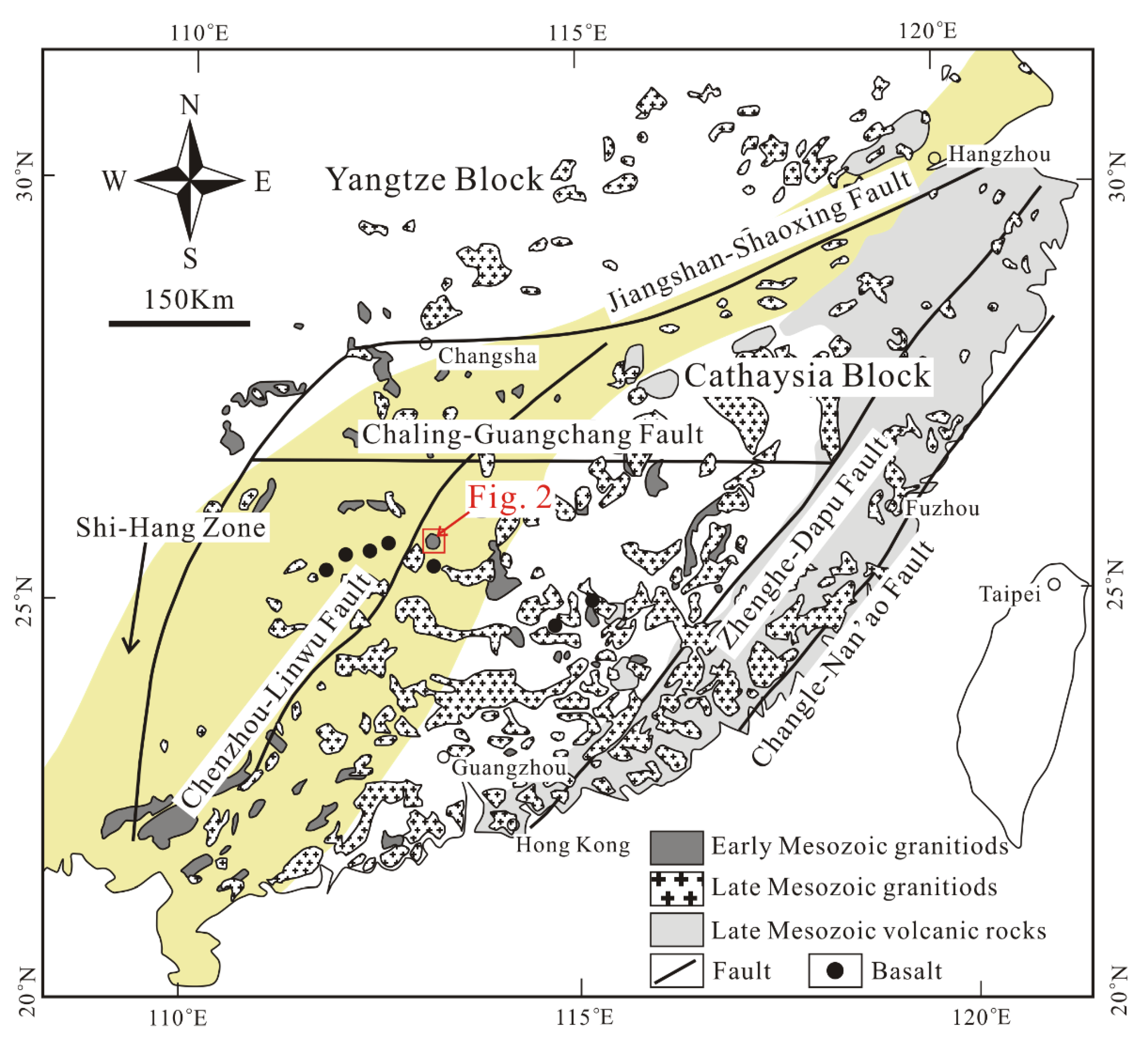
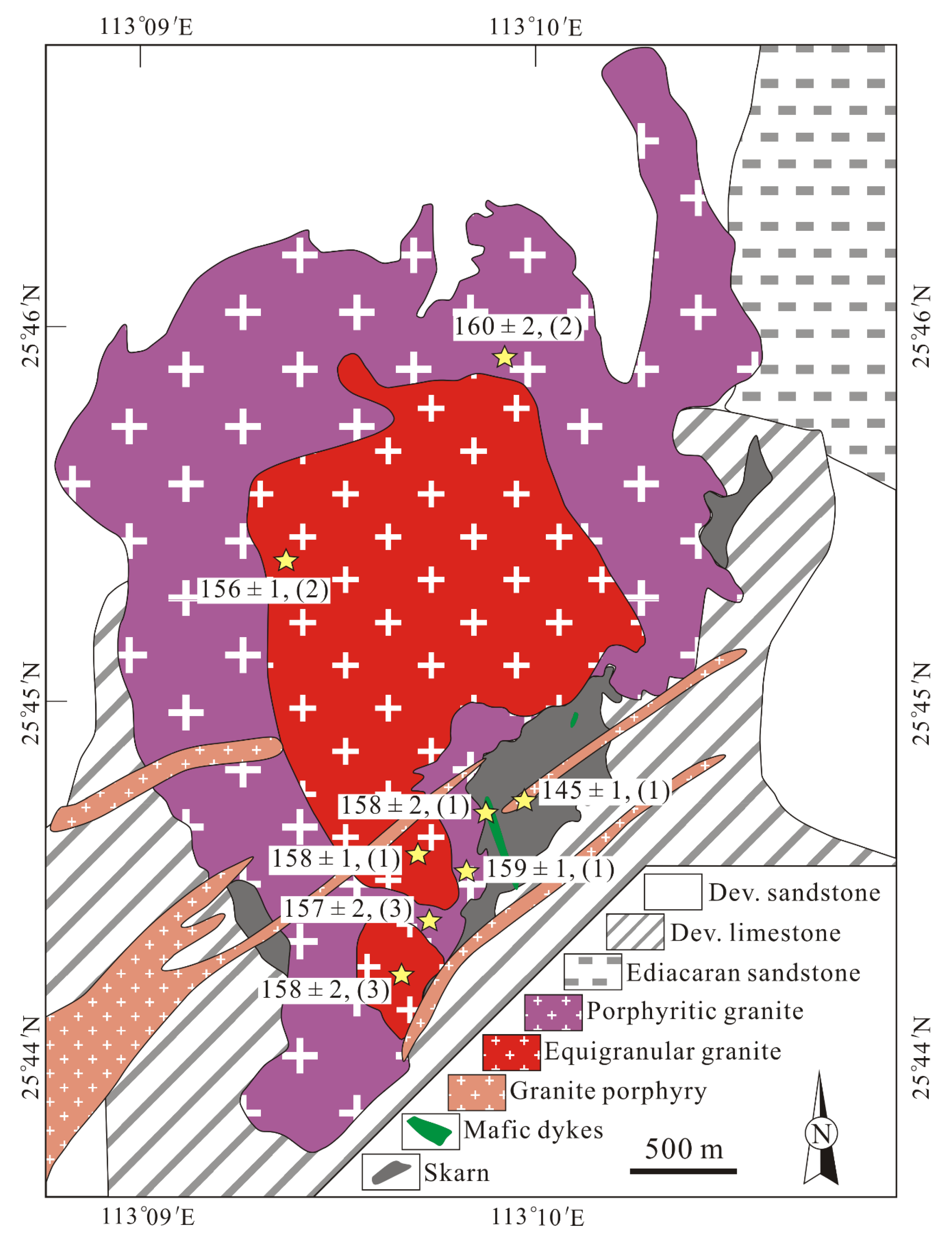
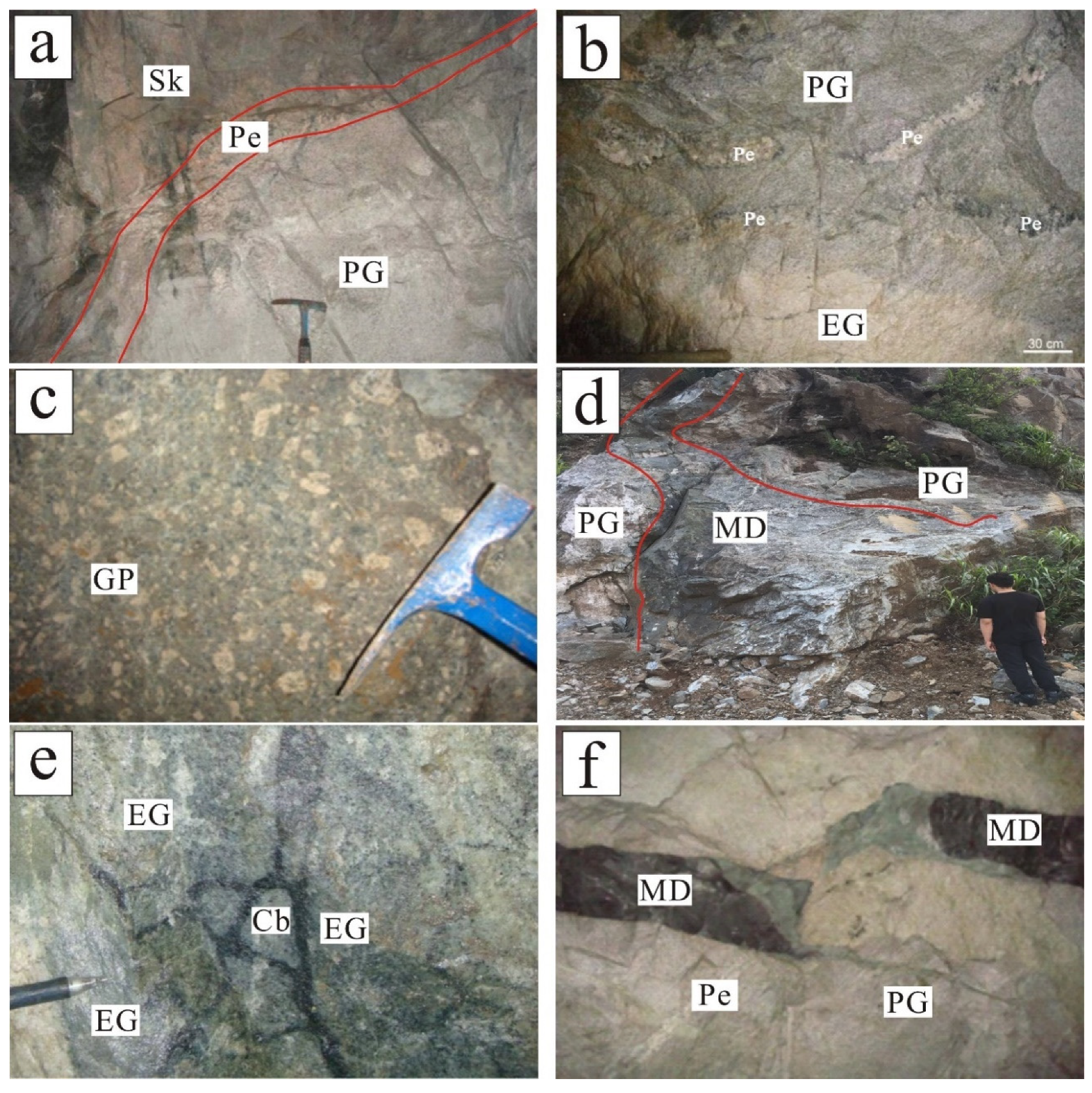
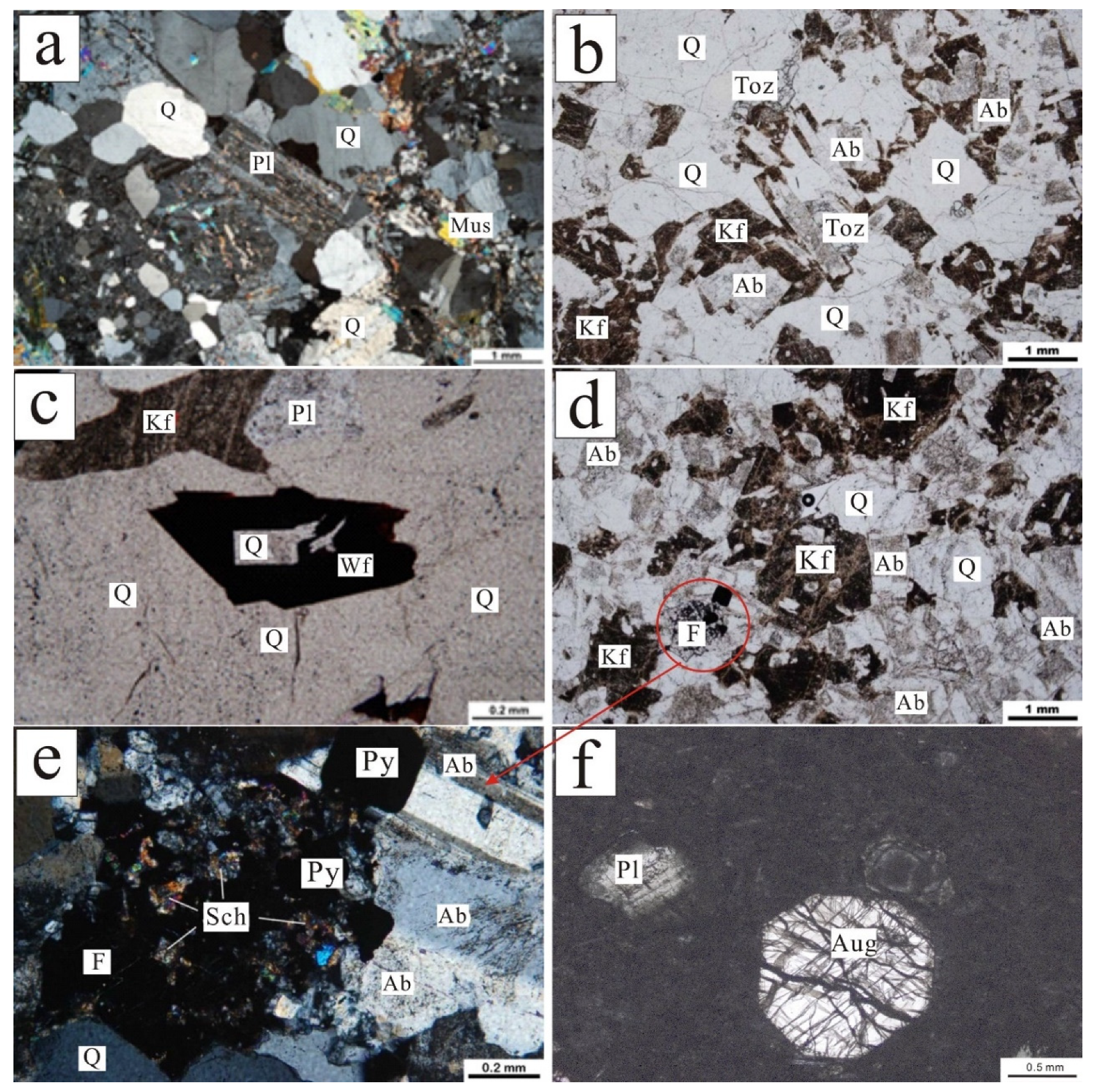
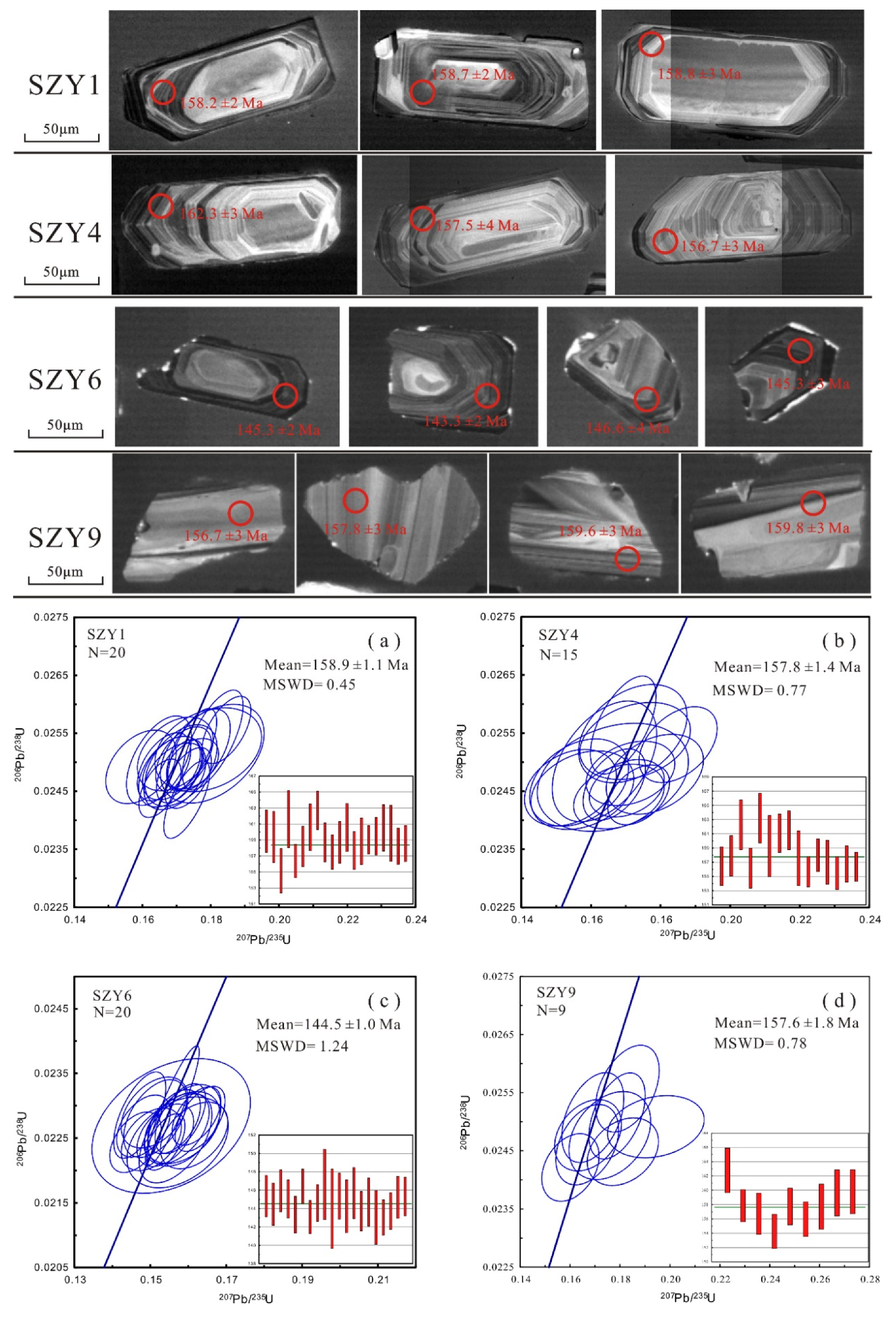
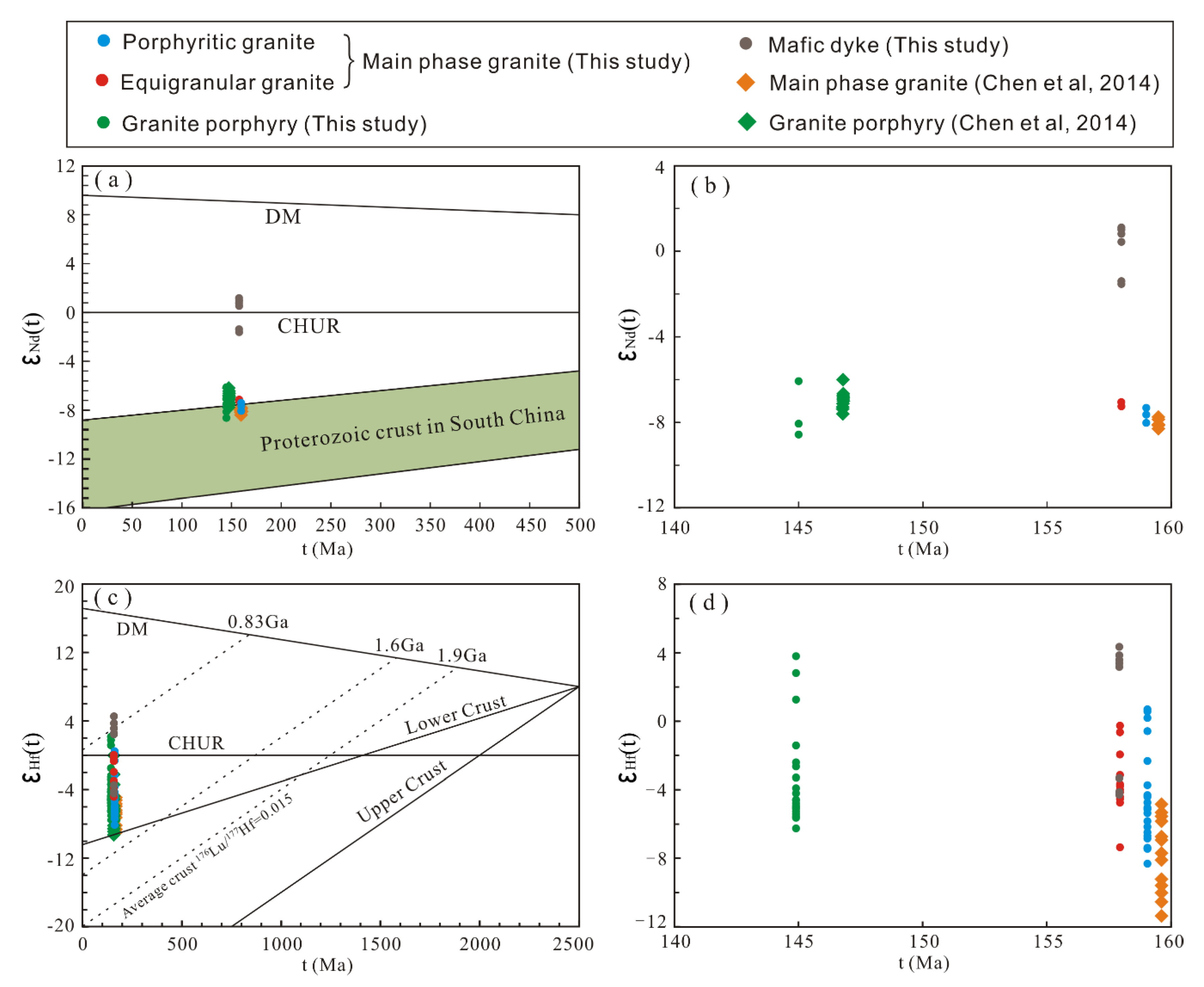
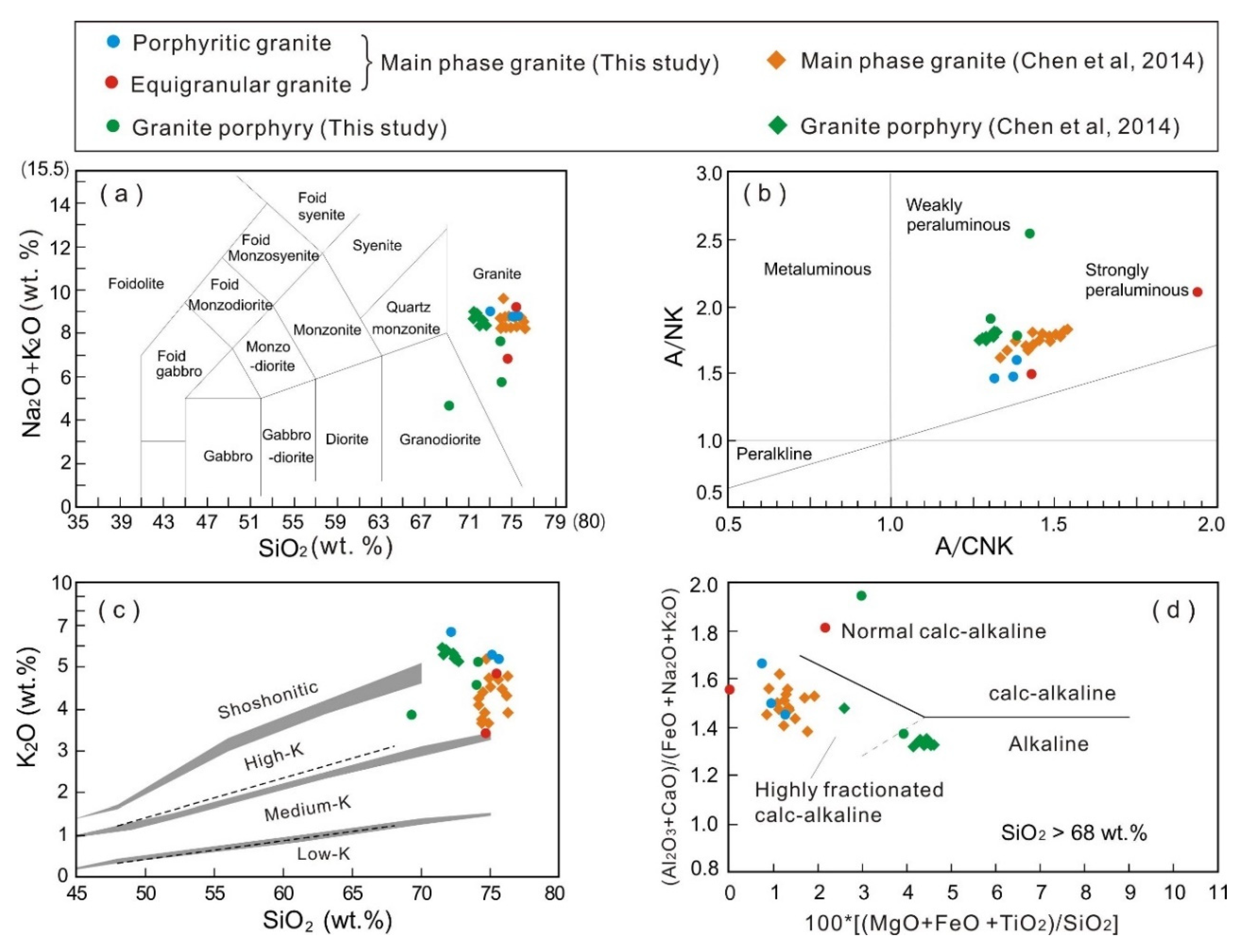

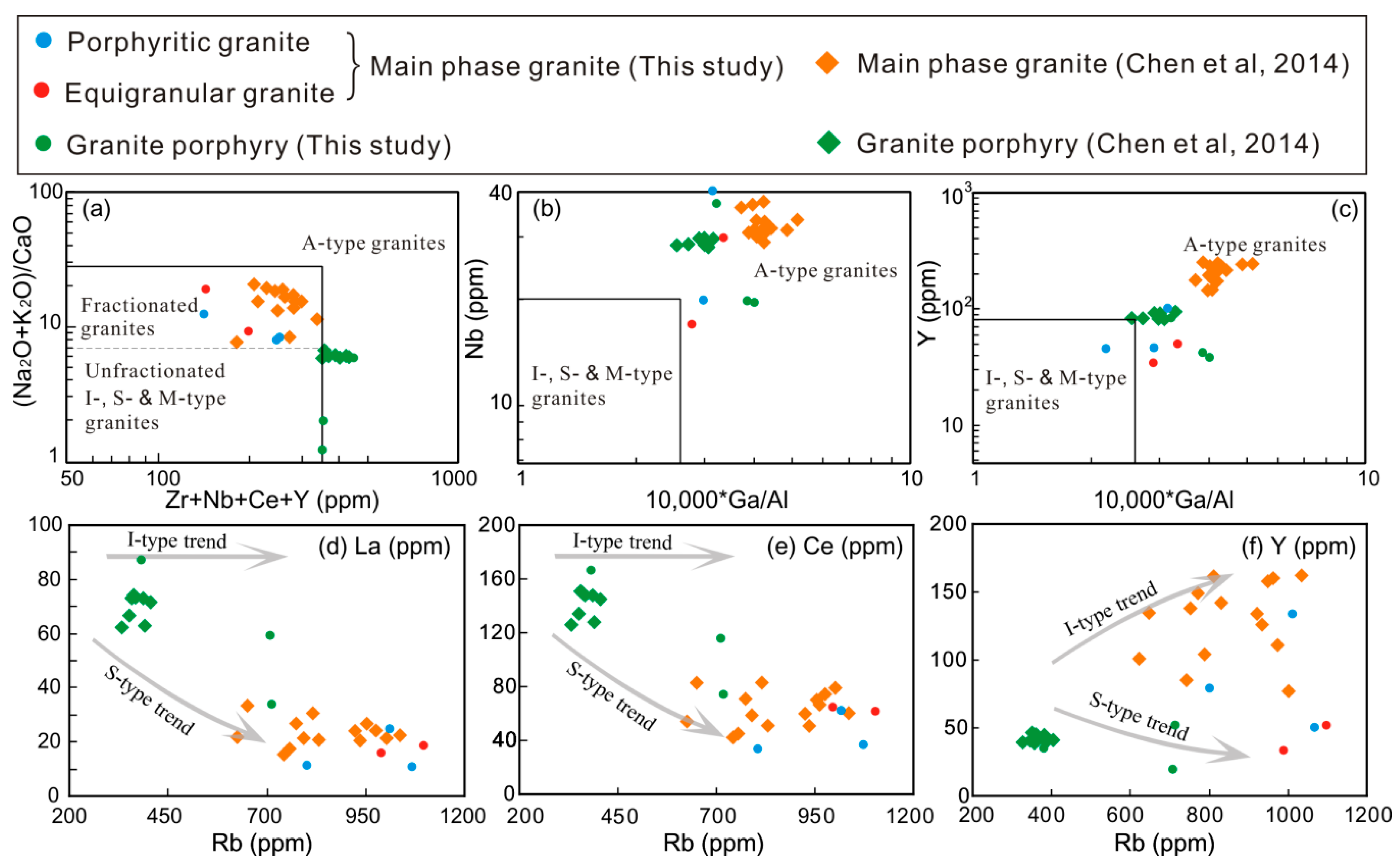
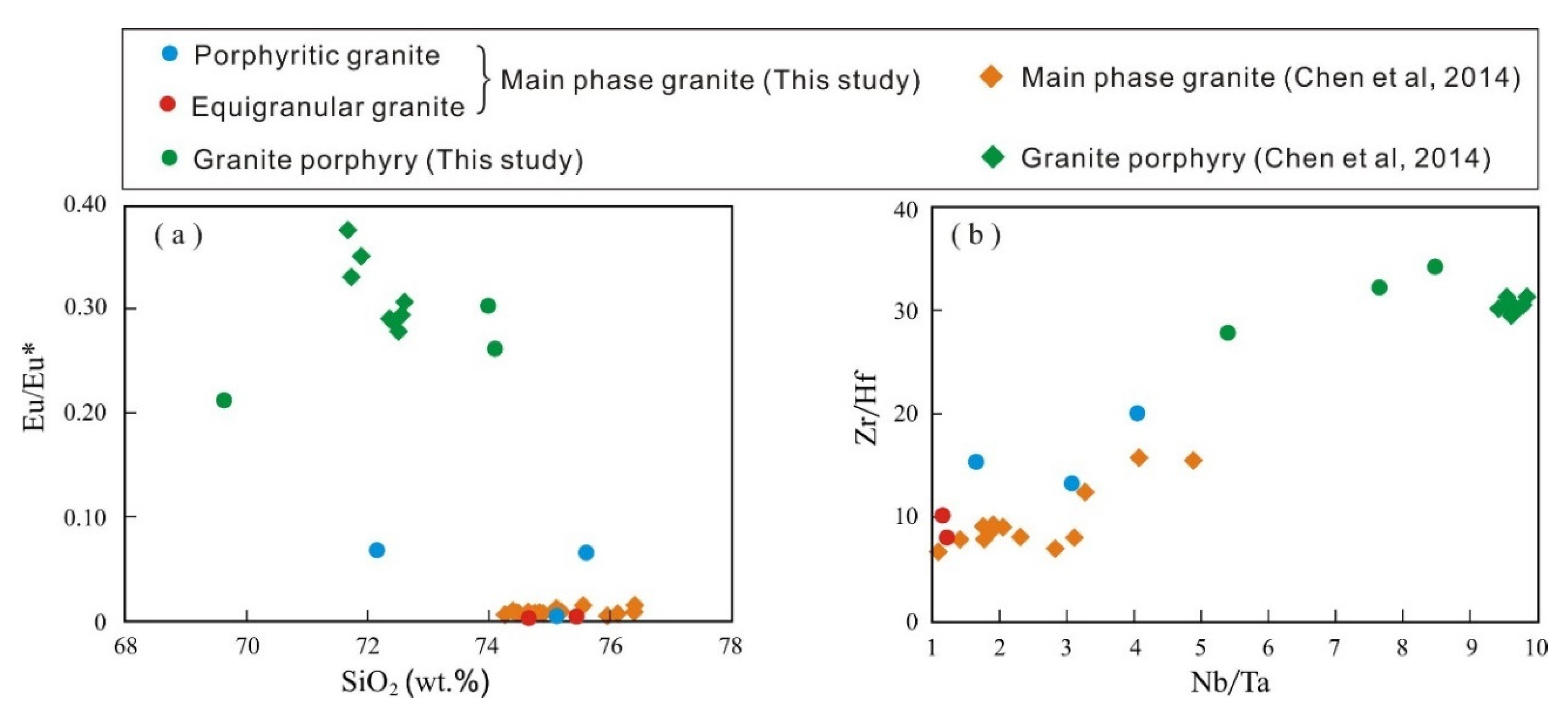
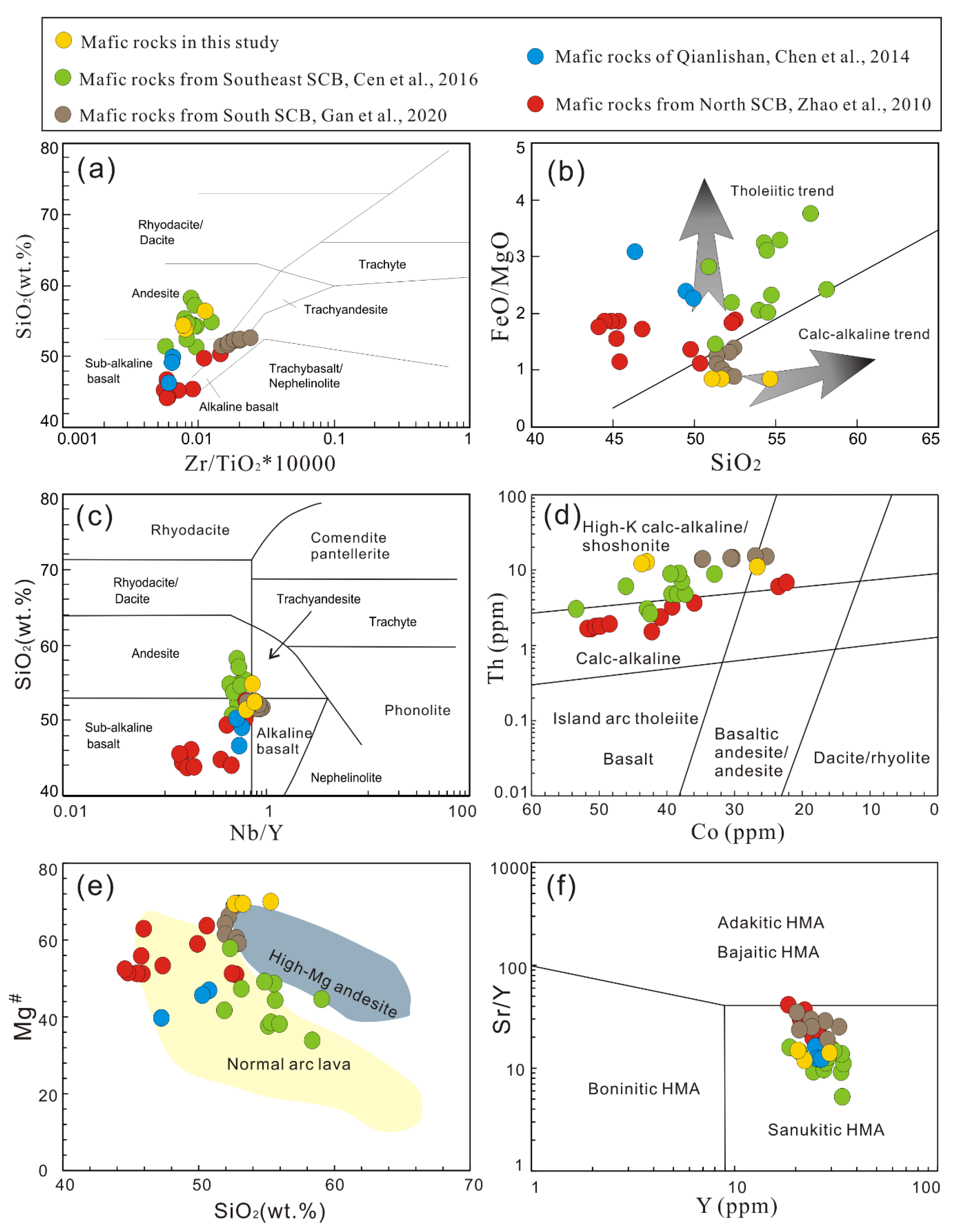
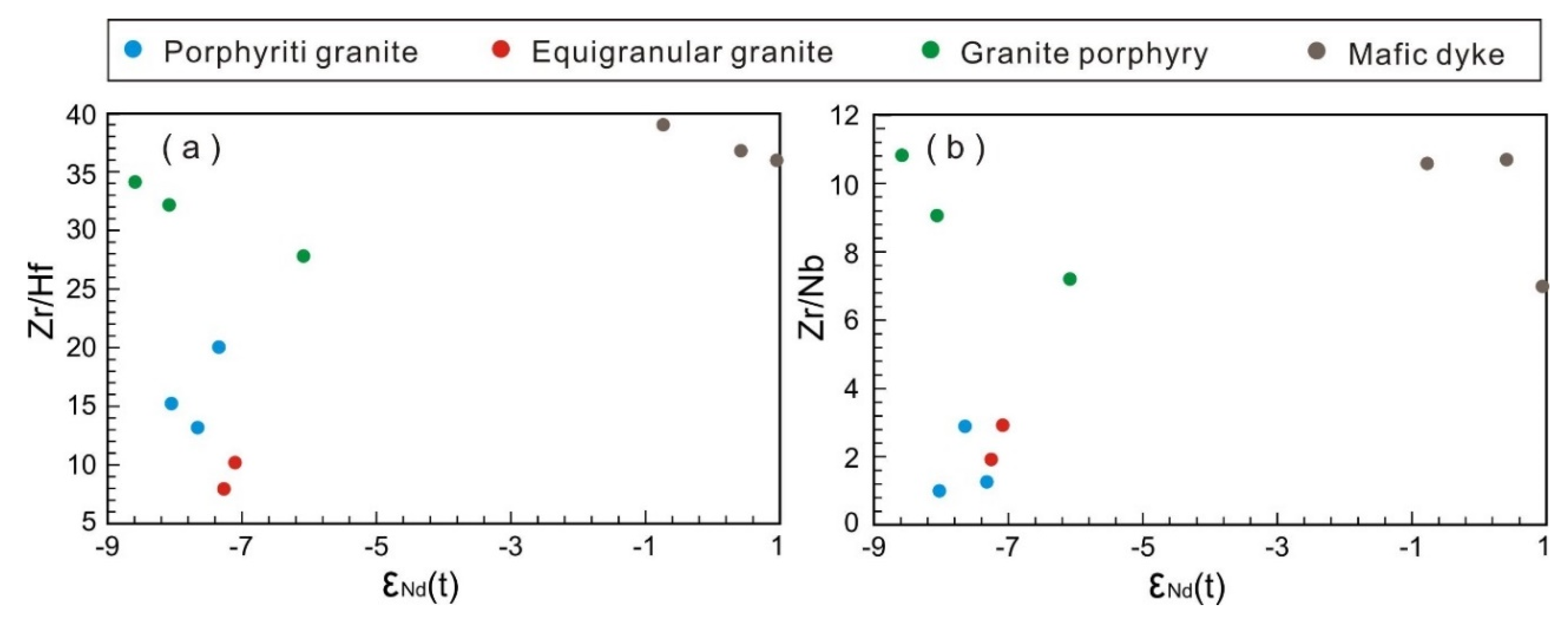
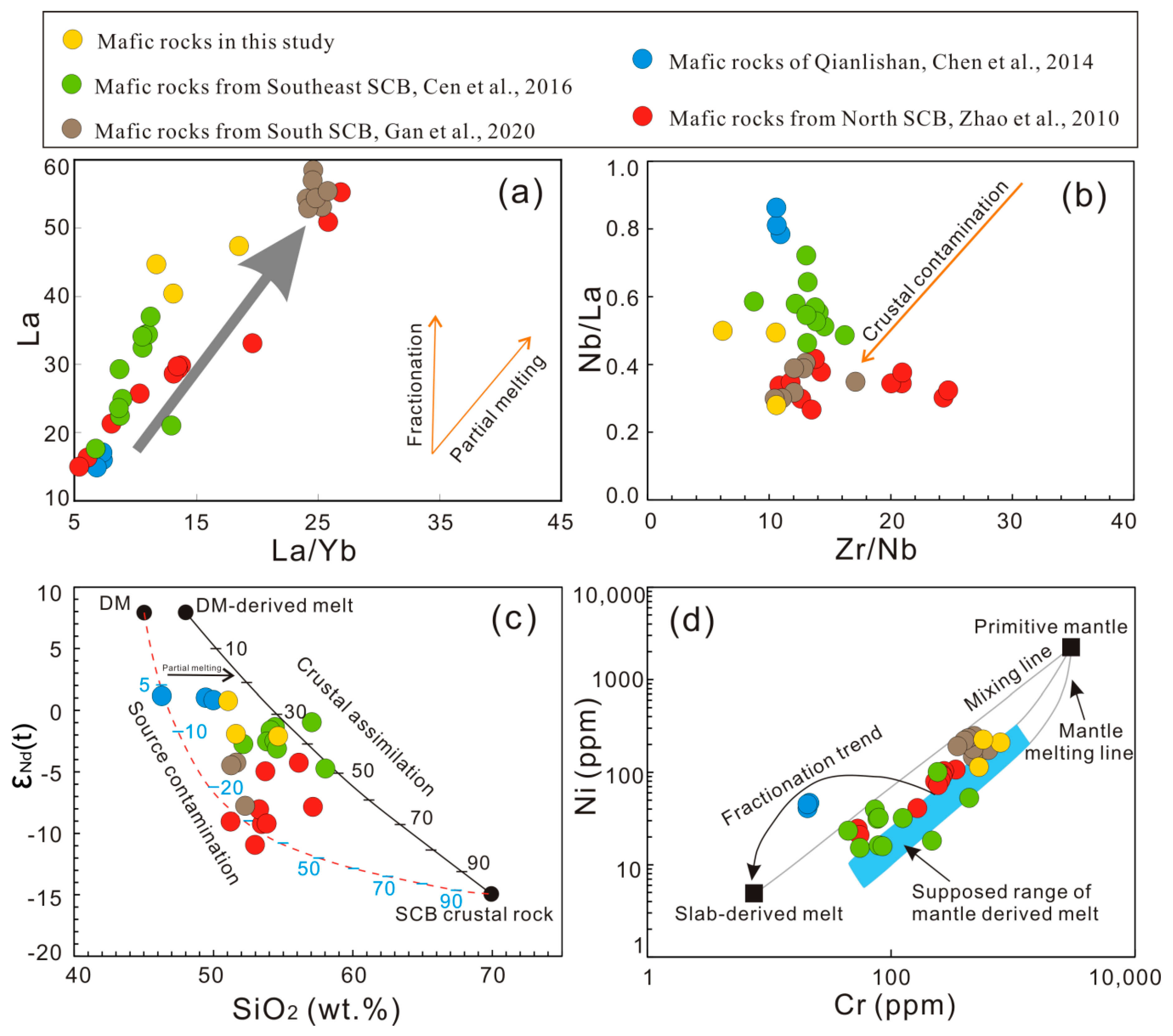
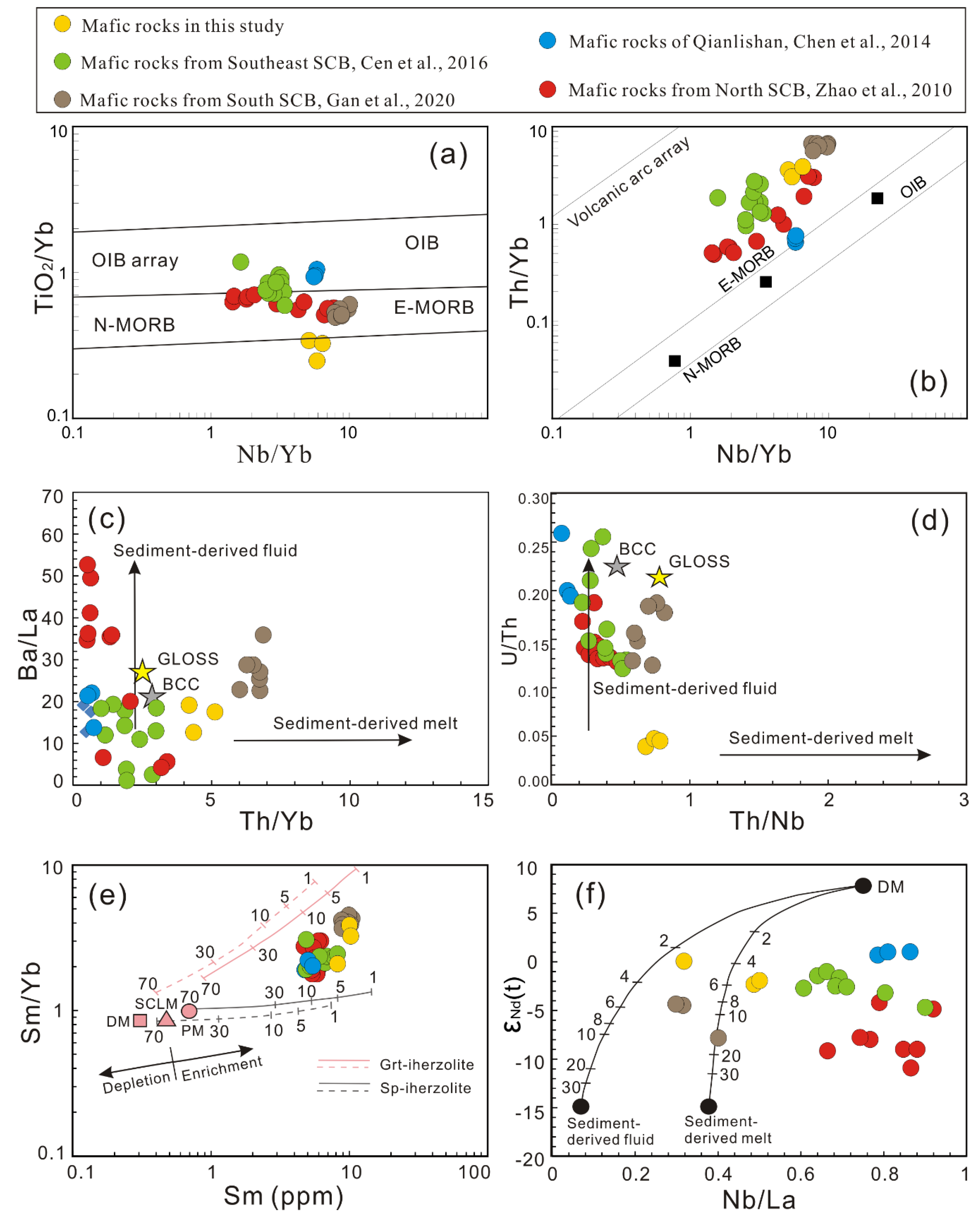
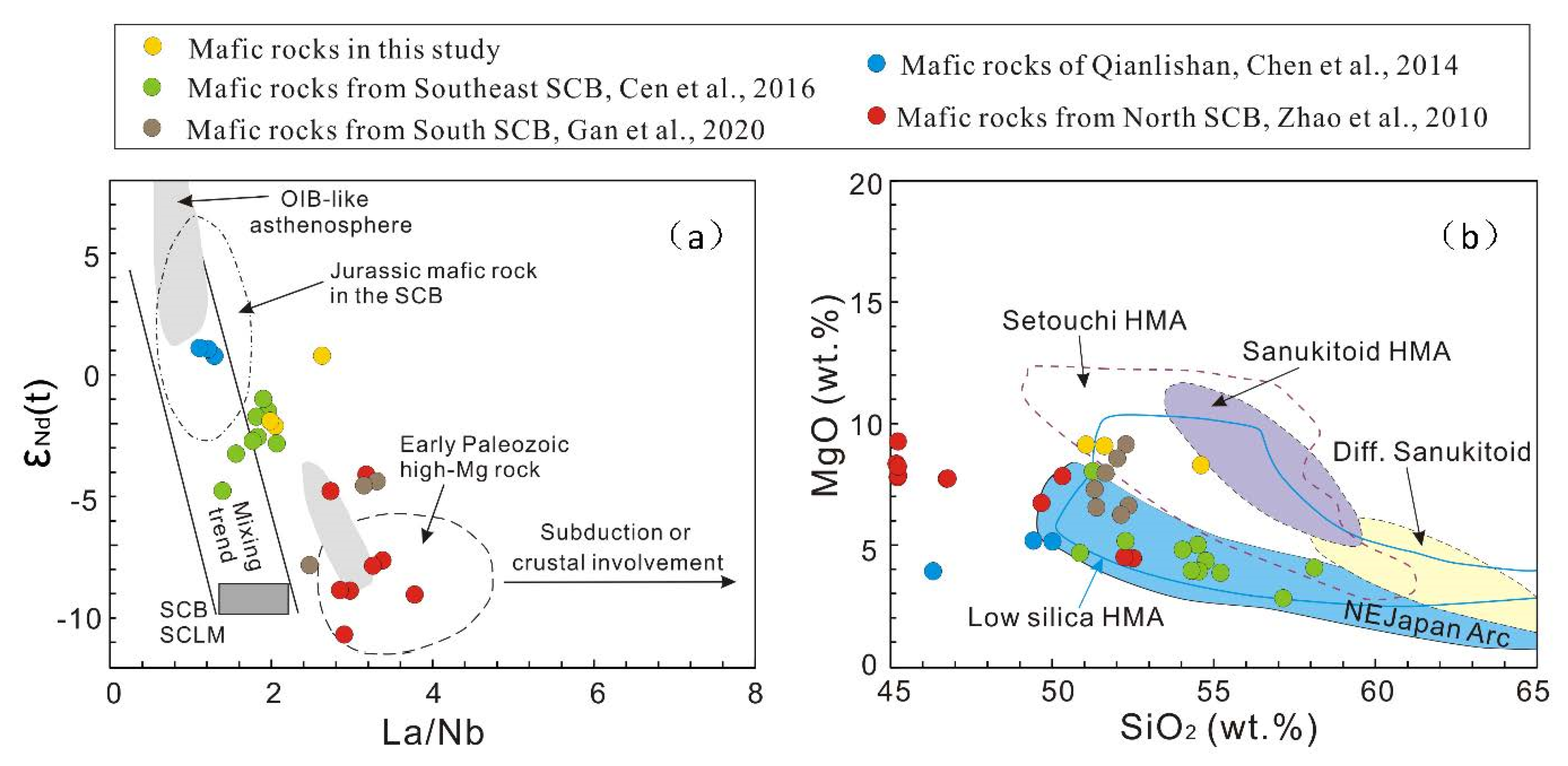
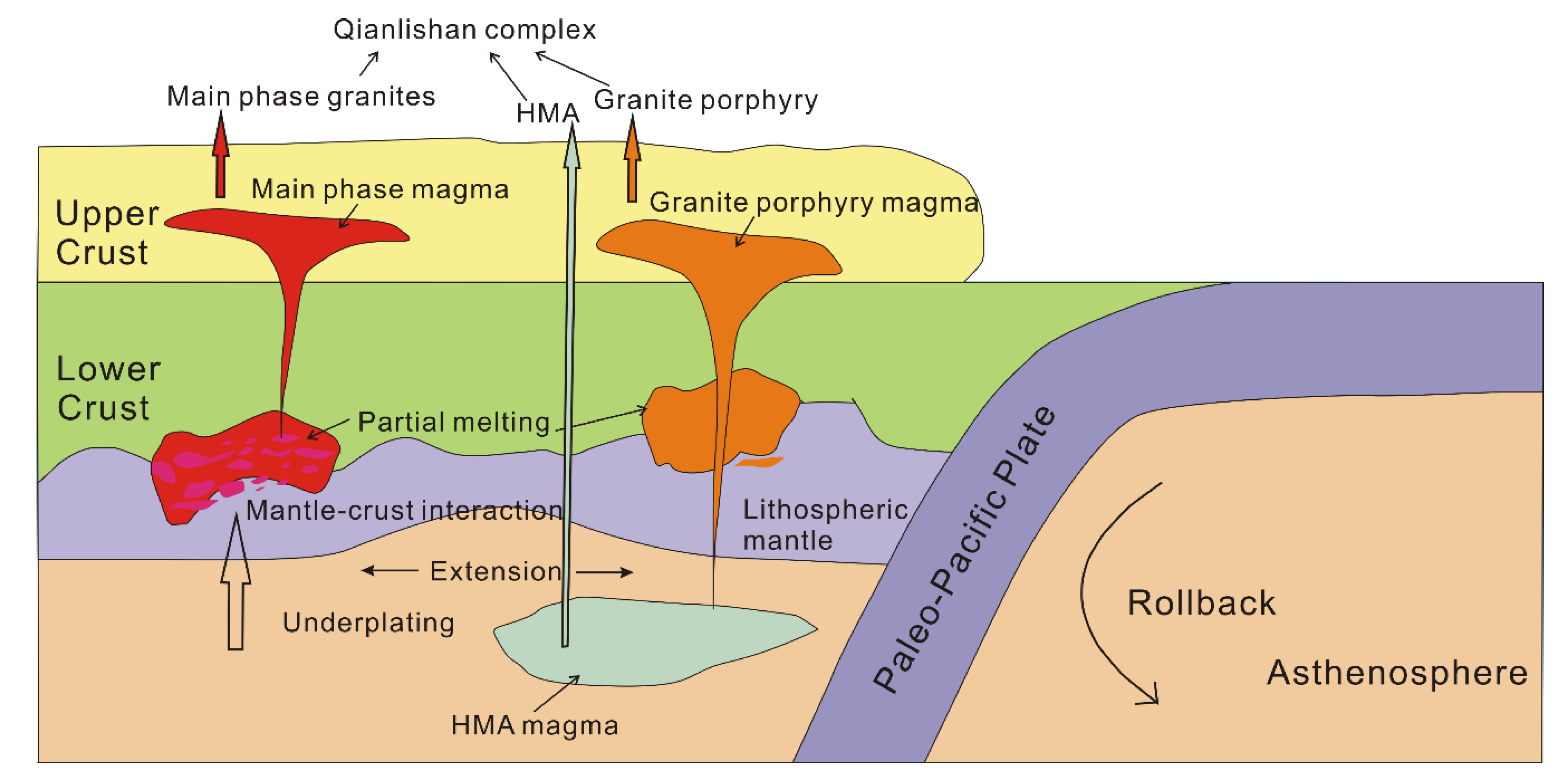
Publisher’s Note: MDPI stays neutral with regard to jurisdictional claims in published maps and institutional affiliations. |
© 2020 by the authors. Licensee MDPI, Basel, Switzerland. This article is an open access article distributed under the terms and conditions of the Creative Commons Attribution (CC BY) license (http://creativecommons.org/licenses/by/4.0/).
Share and Cite
Yu, Z.-F.; Peng, Q.-M.; Zhao, Z.; Wang, P.-A.; Xia, Y.; Wang, Y.-Q.; Wang, H. Geochronology, Geochemistry, and Geodynamic Relationship of the Mafic Dykes and Granites in the Qianlishan Complex, South China. Minerals 2020, 10, 1069. https://doi.org/10.3390/min10121069
Yu Z-F, Peng Q-M, Zhao Z, Wang P-A, Xia Y, Wang Y-Q, Wang H. Geochronology, Geochemistry, and Geodynamic Relationship of the Mafic Dykes and Granites in the Qianlishan Complex, South China. Minerals. 2020; 10(12):1069. https://doi.org/10.3390/min10121069
Chicago/Turabian StyleYu, Zhi-Feng, Qi-Ming Peng, Zheng Zhao, Ping-An Wang, Ying Xia, Yu-Qi Wang, and Hao Wang. 2020. "Geochronology, Geochemistry, and Geodynamic Relationship of the Mafic Dykes and Granites in the Qianlishan Complex, South China" Minerals 10, no. 12: 1069. https://doi.org/10.3390/min10121069
APA StyleYu, Z.-F., Peng, Q.-M., Zhao, Z., Wang, P.-A., Xia, Y., Wang, Y.-Q., & Wang, H. (2020). Geochronology, Geochemistry, and Geodynamic Relationship of the Mafic Dykes and Granites in the Qianlishan Complex, South China. Minerals, 10(12), 1069. https://doi.org/10.3390/min10121069




